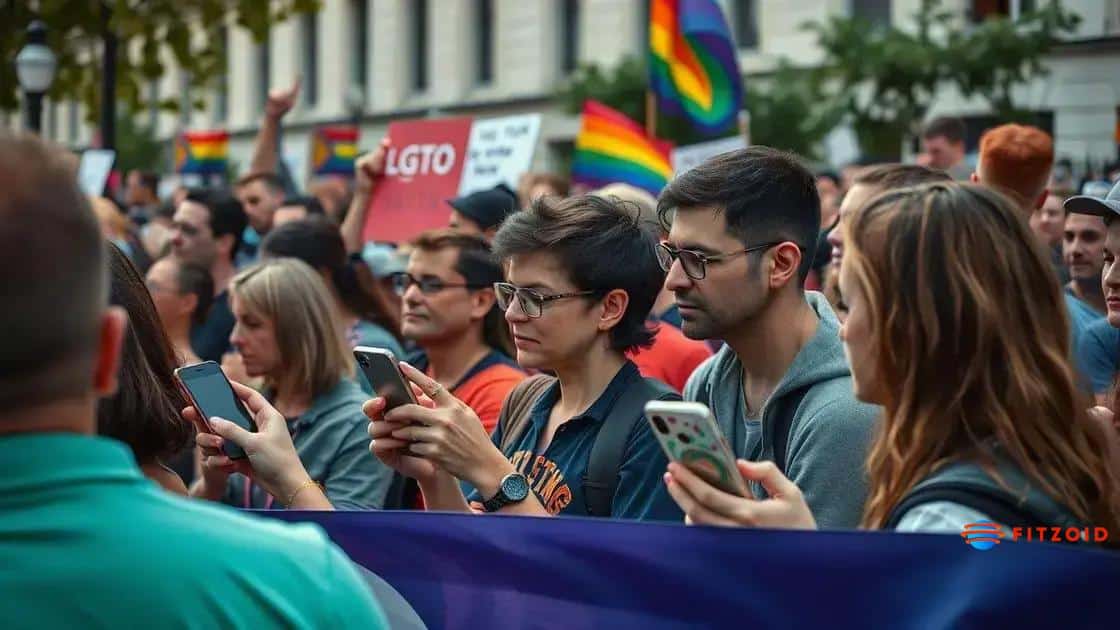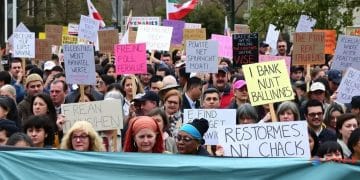LGBTQ+ rights demonstrations: a powerful call for change
Anúncios
LGBTQ+ rights demonstrations play a crucial role in advocating for equality and acceptance, driven by influential activists and the power of social media to mobilize communities and create awareness.
When you think about LGBTQ+ rights demonstrations, what comes to mind? These vibrant, passionate gatherings are not just about celebration; they symbolize a powerful call for change and equality. Let’s dive into the essence of these movements and explore their significance.
Historical overview of LGBTQ+ rights demonstrations
The journey for LGBTQ+ rights demonstrations has a rich and complex history. These events have played a vital role in shaping societal perspectives, fostering acceptance, and advocating for equality. From grassroots movements to large-scale protests, the evolution of these demonstrations reflects the changing tides of public opinion and legislative progress.
Anúncios
Early Beginnings
Historically, the fight for LGBTQ+ rights didn’t gain visibility until the mid-20th century. One of the first notable demonstrations was the 1965 Dewey’s Lunch Counter sit-in in Philadelphia, where LGBTQ+ individuals protested against discrimination. This pivotal moment set the stage for future activism.
Stonewall Riots
The next significant milestone was the Stonewall Riots in 1969. Triggered by a police raid at the Stonewall Inn in New York City, this uproar marked a turning point in the LGBTQ+ rights movement.
Anúncios
- The riots lasted several days and galvanized the community.
- This event is often credited with sparking the modern LGBTQ+ rights movement.
- It led to the first Pride marches in 1970, celebrating resilience and advocating for rights.
The legacy of the Stonewall Riots continues to influence demonstrations today. These early events were not just protests; they were declarations of identity and calls for justice. Over the years, pride parades and rallies became synonymous with visibility, solidarity, and activism.
Global Impact
Today, LGBTQ+ rights demonstrations occur worldwide, transcending borders. Countries with diverse cultural backgrounds join in solidarity for the same cause. For example, events like the Sydney Gay and Lesbian Mardi Gras celebrate not just local culture but also share stories of struggle and triumph.
Such international movements emphasize that the fight for equality is a global pursuit. They serve to educate others, create dialogues, and strengthen rights within different societies. The critical context of these demonstrations helps newer generations understand the importance of activism.
| Theme | Summary | Examples |
|---|---|---|
| Historical Milestones | Key events that shaped LGBTQ+ activism and rights. | Stonewall Riots (1969), First Pride March (1970), AIDS Crisis Activism (1980s) |
| Influential Activists | Individuals who significantly contributed to LGBTQ+ rights. | Marsha P. Johnson, Harvey Milk, Audre Lorde |
| Social Media Impact | Role of digital platforms in organizing and spreading awareness. | Hashtags like #Pride, online campaigns, virtual events |
| Global Demonstrations | Worldwide events advocating for LGBTQ+ rights and visibility. | Sydney Mardi Gras, London Pride, São Paulo Pride Parade |
| Challenges Faced | Obstacles encountered by LGBTQ+ activists and communities. | Legal restrictions, public backlash, misinformation |
| Future Advocacy | Emerging trends and focuses in LGBTQ+ rights movements. | Intersectionality, digital activism, policy reforms |
Key moments that shaped the movement
The history of LGBTQ+ rights demonstrations is marked by several key moments that have profoundly shaped the movement. These pivotal events not only highlight the struggles of the community but also exemplify resilience and determination in the fight for equality.
1970: First Pride March
The first Pride marches took place in 1970, commemorating the anniversary of the Stonewall Riots. Thousands marched in New York City, demanding rights and recognition. This event sparked a tradition that continues today, uniting people globally to celebrate diversity and advocate for justice.
1980s: The AIDS Crisis
During the 1980s, the AIDS crisis became a significant catalyst for LGBTQ+ activism. Grassroots organizations emerged, demanding government action and medical research. Activists like ACT UP led protests, reminding society that human rights must include health rights.
- Advocacy brought critical attention to the need for better healthcare.
- The crisis united many LGBTQ+ individuals in a common struggle.
- This period marked a shift in public perception, highlighting the plight of the community.
The AIDS epidemic challenged the LGBTQ+ community to mobilize, educate, and fight against stigma and discrimination.
2003: Lawrence v. Texas
A landmark moment came in 2003 when the Supreme Court ruled in Lawrence v. Texas, decriminalizing homosexual conduct. This decision was monumental in affirming the rights of LGBTQ+ individuals across the United States. It symbolized a turning point, reinforcing the idea that love is not a crime.
2015: Obergefell v. Hodges
Another pivotal victory occurred in 2015 with Obergefell v. Hodges, which legalized same-sex marriage nationwide. This milestone was celebrated with demonstrations, marking a hopeful moment in the struggle for equality. It underscored the impact of continued activism and resilience within the community.
These key moments illustrate that the fight for LGBTQ+ rights is ongoing and constantly evolving. Every demonstration, every march, and every victory is a step toward greater acceptance and equality.
Profile of influential activists
Throughout the history of LGBTQ+ rights demonstrations, several influential activists have emerged as key figures in the fight for equality. These individuals have dedicated their lives to advocating for change, often sacrificing personal safety for the greater good.
Marsha P. Johnson
One of the most iconic figures is Marsha P. Johnson. She was a prominent activist and drag queen who played a crucial role in the Stonewall Riots. Marsha was known for her vibrant personality and unwavering commitment to the LGBTQ+ community.
- Co-founder of the Street Transvestite Action Revolutionaries (STAR).
- Advocated for the rights of transgender individuals and marginalized communities.
- Helped establish the first LGBTQ+ shelters in New York.
Her work emphasized the need for inclusivity and recognition of all identities within the LGBTQ+ movement.
Harvey Milk
Harvey Milk was another tremendous impact on LGBTQ+ rights. As one of the first openly gay elected officials in the United States, Milk served on the San Francisco Board of Supervisors. His political career was dedicated to empowering the LGBTQ+ community.
- He fought against discrimination and hatred.
- Developed policies that protected the rights of gay individuals.
- His famous slogan, “Hope will never be silent,” inspired many to speak out.
His assassination in 1978 sparked outrage and energized activists, leading to increased visibility for LGBTQ+ issues.
Marsha P. Johnson
Another prominent figure is Audre Lorde, a poet and activist who highlighted the intersectionality of race, gender, and sexuality. Her work encouraged nuanced discussions about the needs of diverse communities within the LGBTQ+ umbrella.
These activists represent just a few of the many voices that have shaped the landscape of LGBTQ+ rights. Their courage and determination remind us that advocacy is essential for social progress.
Impact of social media on demonstrations

The rise of social media has significantly transformed LGBTQ+ rights demonstrations. Platforms like Facebook, Twitter, and Instagram have become vital tools for organizing, sharing, and amplifying messages. Activists can easily connect with supporters and raise awareness on a global scale.
Rapid Information Sharing
Social media enables rapid dissemination of information, allowing events to be organized in real-time. This immediacy is crucial for mobilizing people quickly. Hashtags like #Pride or #LoveIsLove help to gather attention and create solidarity across diverse communities.
- Fast updates keep participants informed about event details.
- Visual storytelling through images and videos captures the essence of demonstrations.
- Users can share personal stories, fostering connection and empathy.
These features have transformed how communities engage with and support LGBTQ+ causes. Activists can share their messages widely, making them accessible to more people.
Building Solidarity
Social media also plays a significant role in building solidarity among LGBTQ+ individuals and allies. Online platforms have provided safe spaces for connection and support. Virtual events, such as live-streamed rallies or discussions, allow those who cannot attend in person to participate.
The collective power of social media helps amplify marginalized voices. Campaigns can gain viral momentum, leading to increased visibility and support for LGBTQ+ rights. This online presence reinforces the message that love and acceptance are universal.
Challenges and Opportunities
While social media offers numerous advantages, it also presents challenges. Misinformation can spread quickly, potentially undermining the movement. Additionally, some individuals may face backlash or harassment for their activism.
Despite these challenges, the impact of social media on LGBTQ+ demonstrations is undeniable. The ability to connect, organize, and advocate for rights has strengthened movements and inspired new generations of activists.
Future of LGBTQ+ advocacy and protests
The future of LGBTQ+ advocacy and protests looks promising, yet challenging. As society evolves, so do the needs and goals of the LGBTQ+ community. New generations of activists are bringing fresh perspectives and strategies to the movement for equality.
Adapting to Changing Times
One significant aspect of future advocacy is adapting to technological advancements. Social media remains a powerful tool for organizing protests and spreading awareness. Activists are becoming more skilled at using these platforms to reach wider audiences effectively.
- Virtual events may continue to complement in-person protests.
- Innovative campaigns can utilize social justice art and viral content.
- Online petitions and awareness campaigns organize support efficiently.
Additionally, younger activists are increasingly focused on intersectionality, ensuring that the voices of marginalized groups within the LGBTQ+ community are heard.
Legislative Challenges
Future advocacy will also face legislative challenges. As some areas see progress in LGBTQ+ rights, others may experience setbacks. Activists will need to stay alert and mobilize quickly to combat proposed laws that threaten rights.
Building coalitions with other social justice movements will be crucial. These alliances can strengthen the fight for LGBTQ+ rights and promote unity among all marginalized groups. Grassroots organizations will likely play a central role in advocating for policy changes.
Community Engagement
Community engagement will remain vital for the future of protests and advocacy. Local organizations that connect with individual experiences can empower people to take action. Education on LGBTQ+ issues will be necessary to foster understanding and compassion among allies.
Future demonstrations may also serve as cultural celebrations, highlighting the richness of LGBTQ+ identities. This approach not only advocates for rights but also builds pride within the community.
In this evolving landscape, the resilience and creativity of the LGBTQ+ community will shape the future of advocacy and protests, ensuring that the fight for equality and acceptance continues.
In conclusion, the journey towards LGBTQ+ rights
The journey for LGBTQ+ rights has been marked by significant milestones and the tireless work of dedicated activists. As we look to the future, it is clear that advocacy and protests will continue to evolve, adapting to new challenges and opportunities.
The power of social media, the commitment to intersectionality, and community engagement will shape the path ahead. Moreover, it is crucial to remain vigilant against legislative challenges while building coalitions that promote unity and equality.
As we celebrate progress, let us remember the importance of activism in fostering understanding and acceptance. Together, we can create a world where everyone, regardless of their identity, can live freely and authentically.
FAQ – Frequently Asked Questions about LGBTQ+ Rights Demonstrations
What is the role of social media in LGBTQ+ advocacy?
Social media helps spread awareness, organize events quickly, and connect people, making it a powerful tool for LGBTQ+ advocacy.
Who are some key activists in the LGBTQ+ rights movement?
Influential activists like Marsha P. Johnson and Harvey Milk have played significant roles in shaping the movement and fighting for equality.
How have LGBTQ+ rights demonstrations evolved over time?
Demonstrations have evolved from small protests to large celebrations and movements that raise awareness and advocate for policy changes.
What challenges do LGBTQ+ activists face today?
Activists face challenges such as legislative threats, misinformation, and the need for intersectionality, requiring ongoing vigilance and collaboration.





